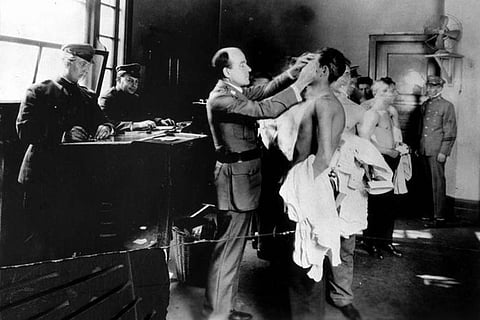
- Home
- न्यूजग्राम
- India
- World
- Politics
- Entertainment
- Culture
- Lifestyle
- Economy
- Sports
- Sp. Coverage
- Misc.
- NewsGram Exclusive
- Jobs / Internships

Twelve Sikhs and one Muslim from the Punjab province in British India landed at the Angel Island Immigration Station on July 29, 1913, in San Francisco Bay and were seeking entry into the United States. The group mostly of the farming profession had sailed on S.S. Persia from Manila, Philippines, then an insular territory of America. While some wished to get into the business, others dreamt of climbing the "agricultural ladder" in time.
The immigration officers held them as "undesirable aliens" from Asia who were likely to become burdens on the American taxpayer. The official reason, however, was "that they are of the laboring class, that there is no demand for such labor and there exists a strong prejudice against them in this locality. The arrival and arrest of the 'Hindus' made news in local dailies, because, traveling aboard the Pacific Mail Steamship Company-owned S.S. Persia, they had been part of a benchmark voyage. While the Persia was a veteran of transpacific journeys, this particular trip had seen it ferry the largest ever number of 'steerage passengers' from Asia.
Follow NewsGram on Facebook: NewsGram.com
The 13 Hindus were individually interrogated by the Immigration Inspector R.E. Peabody and were then formally arraigned, and taken into custody. But one of them, Naram Singh, was released for he either chose to self-deport or was allowed entry—which, is not known. The concomitant bureaucratic reasoning, the medical discourse, framing of legal processes, etc., were all harnessed to stop the Asian migration.
The same sequence of events played themselves out once again, on August 2, in 1913, said the report. When S.S. Korea landed at the docks, all ten 'Hindus' were arrested and detained at Angel Island. Out of the twenty-two, the situation was critical for seven among them—five from the first group, and two from the second, mentioned sada.org Website. They had been diagnosed with uncinariasis, or to be carrying hookworms—deemed a "dangerous, contagious disease" and a threat to public health in America. The only legitimate way to evade this was to admit oneself for treatment under quarantine and bear the expenses accrued which the concerned seven did.
Around the second week of August, the bail bonds, that were required to proceed to the mainland and remain free until their case was decided, began coming in. By the end of the month, all, except the seven afflicted with uncinariasis, had been released from detention on Angel Island under conditions put forth in their bail.
Follow NewsGram on Twitter: @newsgram1
The show of support for the detainees had Commissioner Backus concerned. The telegram to the Commissioner General of Immigrations in Washington D.C., Anthony Caminetti goes like this "Voluminous evidence [have been] presented by attorneys[,]" he informed, "supported by affidavits of prospective employers showing that 'Hindu' labor is needed and desirable and that Hindus are not objectionable to the State [of California]. My views are opposed to this…" But the processing of deportation warrants for the twenty-two Hindus was already in motion.
On October 10, the Department of Labor ultimately issued warrants authorizing the deportation of the Hindus but the writ of habeas corpus at the U.S. District Court for the First Division of the Northern District of California stopped the motion. The hearing began and with it commenced a lengthy tussle that dragged on for nearly two years.
After the Immigration Bureau framed separate charges for each individual detainee, the court closed with the following statement: "We conclude, therefore, that the testimony adduced in the present case was sufficient in character and effect upon which to predicate the findings of the immigration officers, and such findings must be held to be final and conclusive." The Circuit Court of Appeals, Ninth Circuit then upheld the District Court's ruling.
In 1915, a new case involving thirty-five Hindus surfaced. But they managed to secure a hearing at the Supreme Court. On February 21, 1917, a couple of weeks after the U.S. Congress passed the Asian Barred Zone Immigration Act, the following communiqué appeared in newspapers under the headline 'US Admits Error in Excluding Manila Hindus': "The department of justice today notified Timothy Healy…that it would file on March 6 with the Supreme Court a 'confession of error' in the stand taken four years ago when 22 Hindus on arrival here were ordered deported. They arrived from Manila and the U.S. officials held they had no right to enter. This latest move will end the case." And finally after four years since the incident, the Department of Justice admitted before the apex court that it had been wrong in detaining and deporting subjects of the British Empire who entered mainland U.S. through its insular territories, and withdrew all relevant cases.
-by Ajay Krishna, a staff-writer at NewsGram.
ALSO READ:
